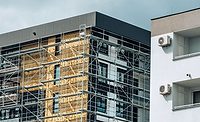Manufacturer Tips
Roofing Assessment: To Repair, Restore or Replace?
Holcim Building Envelope offers advice on assessing a roof’s condition for the most effective repair options

A commercial roof is one of a business’s most important investments. It protects people, products, and infrastructure from the elements and is pivotal in managing energy usage and costs. But like any other part of a building, damage or normal wear to a roof will need to be addressed eventually.
Whether to repair, restore, or replace a roof is an important and nuanced decision. It can be a capital-intensive project, and a building owner’s choices can determine if they extend the life of their building for a few or many more years.There are numerous factors to consider when deciding what to do about a roof, including the age of the building and roof, the current and future purpose/use for the building, whether to include additional insulation, the extent of damage (if any), the type of roof, and the budget.
Repair
To ensure the proper care of a roof, begin by evaluating its condition with a thorough inspection. Examine the roof for punctures and areas where water is pooling, and pay close attention to sections where rooftop equipment installations, including HVAC systems, have taken place. Timely action is essential if any defects are present, such as weak spots or improperly sealed seams, as they can lead to water leakage and increased vulnerability to wind and hail.
For minor leaks and limited damage, patching is a viable solution. Various repair options are designed to adhere to various roof types, from liquid-applied sealants such as GacoPatch, or materials similar to the existing single-ply membrane. For more significant leaks and permanent repairs, the roof may require a full restoration or a tear-off/re-roofing process. Various solutions exist for these alternatives, catering to the roof’s condition and specific needs.
Restore
When deciding between roof restoration or replacement, a key consideration is how many more years of use are expected or needed from the building. If the building owner aims to extend the roof's lifespan by another 10-20 years, and if it is currently in good condition (less than 25% repair needed), opting for a roof restoration through re-skinning or a restorative coating is an excellent choice.
A licensed roofing contractor should understand the roofing regulations for your state, especially in terms of the number of roofing assemblies that can be installed and their overall height in relation to the surrounding walls.
Re-Skin There are several options for existing roofs with only one layer. Adding an additional roof layer can prolong its durability without incurring the full cost of a replacement. Reskinning the roof offers benefits like improving energy efficiency and providing added protection against the elements, extending the roof's lifespan. For reskinning projects, two popular roofing materials are Ethylene Propylene Diene Monomer (EPDM), such as RubberGard EPDM, and Thermoplastic Polyolefin (TPO), such as UltraPly TPO – both offered by Elevate™. RubberGard EPDM is a versatile membrane that offers various installation options, including fully adhered, ballasted, or mechanically attached, ensuring superior long-term weather-ability and exceptional resistance to wind uplift. UltraPly TPO is suitable for different low-slope commercial roofing applications and serves as a sustainable roofing solution for a wide range of building types. While reskinning will involve initial costs, it can yield long-term savings by reducing the frequency of roof repairs and lowering energy bills.
Restorative Coatings Maintenance coating systems provide a cost-effective solution for extending the lifespan of a facility's roof, particularly when there are already two roof assemblies in place, according to 2018 IBC regulations. Coatings are considered a maintenance measure and not a new roof, making them suitable for facilities that have reached the limit of allowable roof assemblies. As a maintenance system, in some cases, coatings can be fully expensed in the year of application, reserving capital for other facility projects.[1] Restorative coating systems offer several benefits, including waterproofing capabilities. By creating a seamless and fully adhered monolithic layer, coatings eliminate seams and glues and provide self-flashing around roof penetrations, reducing the need for additional detail work. Depending on your climate and specific roof requirements, various coating options can be suitable for maintaining your roof. Another advantage of maintenance coatings is their ability to extend the roof’s life by 10-20 years by forming a protective barrier against UV rays, wind, and rain. Additionally, coatings can enhance the roof's aesthetics by covering existing damage or blemishes, giving it a refreshed appearance. GacoFlex offers a comprehensive range of coating solutions for diverse commercial roofing needs, including silicone, urethane, and acrylic coatings. Each can be tailored to maintain and extend the life of existing roof systems.
Replace
When other solutions cannot meet performance or longevity requirements, or if the building has already reached the limit of reroofing and restoration options (with two or more roofs/coating layers), replacing the roof is the final option. Also, if roof damage is widespread and visible, opting for a complete replacement can help to prevent water damage, mold growth, and other related issues. As a professional roofing contractor, you are able to inspect a roof to determine the available options for building owners.
The benefits of a full reroofing project are numerous, starting with superior protection from the elements. And, by bringing the building up to code, a new roof can enhance energy efficiency and reduce energy bills. Recent advancements in roofing insulation contribute to greater energy savings and optimal temperature maintenance. Depending on your region’s weather patterns, the choice of roofing material, whether dark or light-colored, can have specific advantages.
Moreover, a new roof adds value to a building, attracting tenants who are responsible for heating and cooling costs and giving the property an edge over those with older roofs. It also offers peace of mind, especially if a leak would disrupt your business or tenant retention. In areas prone to severe weather, the reassurance of a sturdy roof is invaluable.
Regarding specific roofing materials, TPO single-ply membranes are highly regarded for their cost, performance, and installation advantages, providing resistance to UV, ozone, and chemical exposure. Your roofing contractor will guide you in choosing between self-adhered, fully adhered, or mechanically attached TPO roofs based on your building's needs. EPDM roofing membranes are also a popular choice, known for their durability, longevity, flexibility, and UV resistance.
In Closing
When deciding whether to repair or replace a roof, it's crucial to make an informed choice based on the specific circumstances. As a building owner or manager, receiving trustworthy advice is paramount, and partnering with a reputable manufacturer. By working with experts, you can gain comprehensive knowledge about all available choices, empowering you to make an informed decision.
<1] please consult your tax or accounting professional | Article and Photo Provided by Holcim Building Envelope.
Looking for a reprint of this article?
From high-res PDFs to custom plaques, order your copy today!






